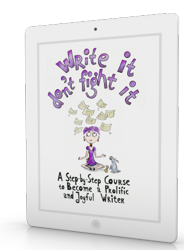How To Put Thoughts Into Writing
To get your thoughts onto paper can feel hard. It becomes easier when you select a writing strategy (or process) that works for you.
![]()
Get your thoughts on paper

Has it happened to you, too?
In your mind, you've composed your next article. Perhaps while walking your dog or on your commute.
You feel excited, because you know exactly what you want to write, and you think your readers will love it. Yay!
Brimming with enthusiasm, you arrive home. But it's your turn to cook, and when, after dinner, you finally sit down to write …
You can't put your thoughts into words anymore. Where have your words gone?
You had such a bright idea, but now you feel lost. How did that happen? Was your idea rubbish? Where did it go?
Want to write faster and better? Get my best writing tips here > > >
Writing isn't like assembling a flat-pack bookcase
A flat-pack comes with instructions on how to turn a collection of parts into a bookcase. While it may seem like chaos at first, the outcome is pretty certain—as long as you follow the instructions step by step.
But writing?
Not only do you need to collect the "parts" yourself, you also have to find your own method of assembling those parts into a shiny piece of content. And what's more, creativity means stepping into the unknown: The outcome may be a little uncertain or completely shrouded in mist.
Writing is laborious:
- Writing is thinking; and thinking is tough.
- Writing is communication; and communicating with clarity is hard work.
- Writing is a creative process; and creativity seems a fickle beast.
Many writing coaches may advise you to follow a specific process—as if an IKEA method for writing exists. But what might work for your writing coach, might not work for you and me. We're all different.
So how can you get rid of writing frustrations? And how can you turn yourself into a productive writer? How can you put fleeting thoughts into solid writing?
Well, it depends. Are you a carpenter, a knitter, or a free spirit?
Shall I explain?
1. The Carpenter's Method
Like many writing coaches, Jack Hart recommends the Carpenter's Method in his book "A Writer's Coach." He quotes one of his workshop participants:
Years ago I used to futz with every sentence, but then an editor told me something that really made sense. He said that when a carpenter builds a piece of furniture he doesn't first make one side, perfect that, and then construct another side and perfect that. He must build the entire frame and then go back and put the finishing touches on each section. Even when I am on deadline, I think of what I write first as an imperfect frame that will be improved later.
This is probably the easiest way to produce content relatively fast:
- Choose an idea
- Outline your post
- Write a rough draft
- Revise your content
- Edit sentence by sentence
Steven Pressfield applies this same method when writing fiction. He calls it the "clothesline method." On his clothesline, he hangs a series of scenes and sequences to decide what'll happen in his book.
Some people find this process too structured; they're afraid it might kill their creativity. But an outline is not a straightjacket.
Your outline might be a short list of questions you want to answer, a list of steps your readers must take to solve a problem, or a detailed list of arguments why readers should hire you.
As a writer, you're in charge. You can make your outline as detailed or brief as you like. You can follow it meticulously or remain open for new ideas. It's often a matter of personal preference and how familiar you are with the piece of content you want to write.
For instance, when writing sales copy, I plan meticulously. But for tutorial-style articles (like this one) I'm more open for fresh ideas and my outlines are brief. For a book, I outline what goes in each chapter, but I might write the chapters themselves more loosely.
2. Freewriting
With freewriting, you start writing without quite knowing where your content will end up. You write as fast as possible to uncover new ideas.
The process usually works as follows:
- Write down your ideas as fast as possible
- Find the essence of your content
- Revise your content to build on your key idea
- Edit sentence by sentence
In his book "Accidental Genius," Mark Levy recommends freewriting as a method to boost creativity:
[Freewriting] pushes the brain to think longer, deeper, and more unconventionally than it normally would. By giving yourself a handful of liberating freewriting rules to follow, you back your mind into a corner where it can't help but come up with new thoughts. You could call freewriting a form of forced creativity.
And in his book "Writing Without Teachers," Peter Elbow recommends freewriting as a way to overcome writer's block:
Practiced regularly, [freewriting] undoes the ingrained habit of editing at the same time you are trying to produce. It will make writing less blocked because words will come more easily. You will use up more paper, but chew up fewer pencils.
As Elbow suggest, freewriting also helps discover your voice and write with more energy:
In your natural way of producing words there is a sound, a texture, a rhythm—a voice—which is the main source of power in your writing. I don't know how it works, but this voice is the force that will make a reader listen to you, the energy that drives the meaning through his thick skull.
I use freewriting when writing more personal posts. I often have an inkling of what I want to write about, but the post often turns out completely different from what I had in mind.
3. The Knitter's Method
While the carpenter works from the big framework towards the nitty-gritty, the free spirit just starts and sees where her piece of content will end up. The free spirit often does a lot of revising to create focus and flow.
Both carpenters and free spirits tend to leave editing last. They first get the content right before polishing each word.
The knitter is different. He makes each part of the content perfect before moving on.
As Mark McGuinness writes:
One of the sacred cows of the creative thinking industry is that we should separate idea generation, execution, and evaluation, so that they don't interfere with each other. But my experience as a writer and coach suggests that this isn't how many creative professionals work.
When I'm writing, I'm reading, evaluating, and tweaking as I go. I'll write a few sentences then pause and go back to read them through. Sometimes it's immediately obvious I haven't quite captured the thought or image, so I'll make a few changes before I go on. If I get stuck, I'll stop and read through the whole piece, trying to pick up the thread of inspiration where I lost it. Once I see where I got tangled up, it's a relief to untangle it and get going again.
Experienced writers may thrive on the Knitting Method. But for beginning writers the risk is spending a lot time knitting perfect paragraphs that may later need to be cut. The process may feel more organic and creative, but can take longer, too.
When I feel stuck writing, I might turn to knitting. Instead of finishing a first draft, I polish what I've already written. While editing, I might get an idea on how to write the remaining parts.
So what's the best way to write?
No perfect writing strategy exists.
And most of us mix strategies depending on what we write, how the writing goes, and perhaps even depending on our mood. Sometimes you may find yourself mixing all methods for writing one piece of content.
What's important is to pay attention to what works for you. When do you get in a flow? What triggered this flow? Can you repeat it next time?
Writing requires both planning and an open mind
There is a fine line between good planning and overplanning. You never want the planning to inhibit the natural evolution of your work.
~ Twyla Tharp (The Creative Habit)
We all need a process to keep producing and to pull us through when we feel stuck.
But we also need room for surprise.
When we're open minded, we discover unexpected nuggets of wisdom, fresh ideas, stories, or metaphors.
So find your own balance between planning and openness.
Because that's how you find your flow, quieten your inner critic, and discover the joy of writing.
Recommended course:
Write It, Don't Fight It

A Step-by-Step Course to Become a Prolific and Joyful Writer
"The tools to master the writing process are helping me write and get unstuck faster."
~ Isabel
![]()
How To Put Thoughts Into Writing
Source: https://www.enchantingmarketing.com/writing-strategies/
Posted by: culbertsoncrin1958.blogspot.com

0 Response to "How To Put Thoughts Into Writing"
Post a Comment